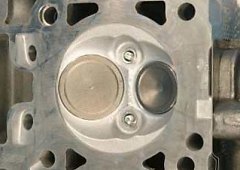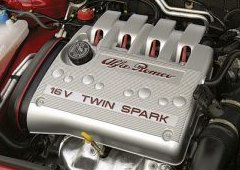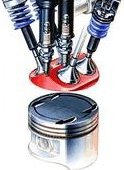|
AUTOZINE TECHNICAL SCHOOL
Throttle Throttleless engines - BMW Valvetronic BMW's
Valvetronic engine is the world's first engine getting rid of throttle
butterfly. What's the advantage ? BMW claimed it saves around 10% fuel
compare with conventional engines.
To understand how throttleless engine save fuel, we must first know how our conventional engines work. When you floor down throttle pedal, you do not control the amount of fuel injection (which would have led to change of air-fuel mixture ratio hence misfire) but the amount of air running into the cylinders. Fuel injection system monitor the amount of air passing the throttle butterfly and then determine the corresponding amount of fuel needed. The more the throttle butterfly opens, the more air runs into the combustion chamber. This is how your throttle pedal control the engine. The below picture shows a conventional engine with throttle butterfly in the intake manifold. 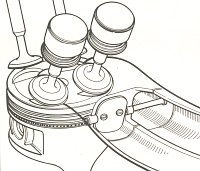 However, as you can see in the picture as
well, at light throttle (when
the car is running leisurely, down hill or at light load) the throttle
butterfly partially or even nearly closes. Simultaneously, the pistons
are still running, sucking air from the partially closed intake
manifold. Needless to explain, the intake manifold between throttle and
combustion chamber will become partial vacuum, resisting the sucking /
pumping action of pistons. This waste energy. Engineers called this
energy loss as "Pumping Loss". The slower the engine runs, the more the
throttle butterfly closes, thus the more energy loss.
Valvetronic mechanism get rid of throttle butterfly thus saves fuel, especially at lower rev. According to the EU combined test cycle consist of high speed and low speed running, the 1.8-litre Valvetronic engine used by 316ti Compact saves 10% fuel (at 53.3 mpg or 5.3 litre / 100 km). For those who regularly drive in city, the saving could be bigger. Moreover, unlike direct-injection (the most popular fuel-saving technology right now), it need not to drink low-sulphur gasoline. 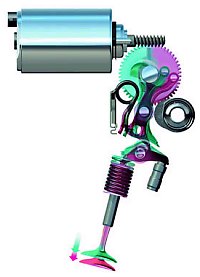 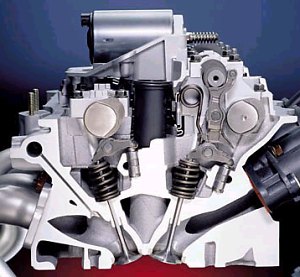 Without throttle butterfly, how does it
control the amount of air
entering cylinders ? by controlling the lift of valve. Valvetronic is
essentially a variable valve lift system acting on intake valves.
Compare with conventional twin-cam engines with finger followers, it
employs an additional eccentric shaft, an electric motor and several
(one per valve) intermediate rocker arms (see picture). The motor
control the angle of eccentric shaft, which rotate the angle hence
depth of the intermediate rocker arms acting on finger followers, which
in turn activate opening and closing of valves. If the rocker arms push
deeper towards finger followers, the intake valves will have higher
lift, vice-versa.
Now you might think about Honda's VTEC. Can Valvetronic use its variable lift to increase power like VTEC ? Sadly, Valvetronic is actually less efficient at high rev than conventional engines, let alone VTEC. As you can see, the camshaft drives the long intermediate rocker arms, in turn drive finger followers, this generates quite a lot of friction. Therefore the efficiency and refinement of Valvetronic engines drop rapidly at over 6,000 rpm. No wonder in the foreseeing future BMW will not equip its M-power engines with Valvetronic. Ignition Twin-spark
plugs
Talking about twin-spark, you might remember Alfa Romeo. For 2 decades (from mid-1980s to early-2000s) the Italian company promoted the Twin Spark technology very hard on its four-cylinder engines. Twin-spark plugs per cylinder was also used in the last air-cooled Porsche 911s (964 and 993) and Mercedes-Benz 3-valve modular V6 / V8, but now only Chrysler's Hemi V8 still carries this feature. Why? Because twin-spark is most benefitial to engines with 2 or 3 valves per cylinder. On such engines, spark plugs are usually offset to one side - rather than located centrally as in the case of 4-valve heads - in order to maximize the area of intake and exhaust valve. This hampers the efficiency of ignition, as the frame takes longer distance to travel from one side to another. On a high-revving engine where combustion takes less than a hundredth of a second, the speed of flame propagation could be a limiting factor to rev and output. Moreover, imperfect burning may lead to more pollutants and higher fuel consumption.
|
||||||
| Copyright© 1997-2015 by Mark Wan @ AutoZine |
